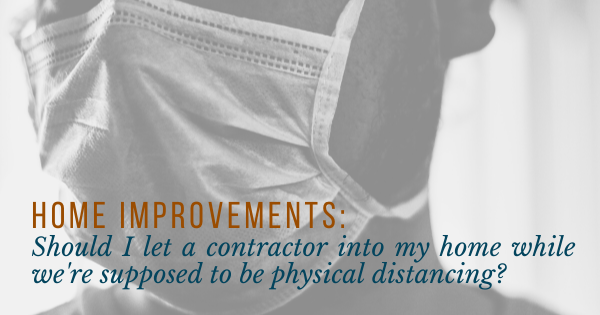Whether it’s for emergency maintenance, routine maintenance or a reno, should you be letting a contractor into your home when we should be physical distancing?
While things are starting to open back up, physical distancing rules still apply. We can all agree that these are some of the craziest months we’ve experienced in our lifetimes thus far. We’re also figuring things out as we go along in a world where the rules and information are changing constantly. We are physical distancing but trying to create a new “normal” and keep our minds and bodies occupied with the tasks we CAN do.
I’ve been talking to a number of people who are taking this time to complete some projects around the house. Some a full scale renos and others are smaller jobs that they just need to tick off the “honey do” list. But, before you dive head on into the project, think about whether you’ll need a professional’s help at some point.
Contractor Physical Distancing: Outdoor Projects
Now is a great time if you need to hire someone for outdoor projects. Maybe some landscaping work, or siding, roof or eavestrough maintenance. No contact required.
The contractor won’t be in your physical space and you don’t have to worry about disinfecting etc. Of course, if you do go outside to have a discussion about the project, physical distancing is the best practice. You might also want to wear a mask if you aren’t feeling well.
Regardless of the size of the project, so much can be done online or via email and phone, including approving drawings, discussing requirements, and even viewing invoices and making payments.
Contractor Physical Distancing: Indoor Projects
It has been recommended that you not invite contractors into your home unless it is an emergency. Even if you aren’t home at the time or stay on another level of the home, unless you plan to disinfect everything they’ve touched, it is risky for both you and the contractor. While physical distancing may not be an issue, what is their commitment to cleaning and disinfecting?
No matter what the project, inside or out, make sure to ask the professional coming to your home if they are feeling well, have not been in contact with anyone that has tested positive for COVID or are being tested. If you don’t like the answers, call another contractor or postpone the service until they are feeling well.
You should still be very concerned about what they have touched. If you’re not there, you can’t be sure. Question them about their disinfecting protocols and again, if you don’t their answers look elsewhere.
What about service calls?
So what if your internet is down or your oven died? Well, some things can’t be put off. Who could survive without Netflix these days?
While physical distancing , frequent and thorough hand-washing, and cleaning of potentially affected surfaces go without saying, here are strategies to protect everyone involved through the four strategies of a service call.
Scheduling your appointment
It’s critical for all parties involved to be honest about their exposure, right up to the time of the appointment. If you or the contractor is not comfortable proceeding with the appointment, it should be rescheduled without penalty.
You should also be able to request a touch-free transaction. From documentation and sign off to payment, all can be done digitally or online.
Will the contractor or technician be wearing a mask and gloves and how are they combatting the risks of COVID when they enter a home? I’ve heard that some companies are limiting the number of employees in the home and sanitizing job sites while working.
Preparing your home
Plan how you’ll direct the person through your home, and where to suggest they put their tools. You’ll want to make sure that they don’t go into rooms or touch items in your house unnecessarily.
Pre-clean the area where the worker will be based, with a cleaner known to kill the virus. That protects them in the event the virus is in your home, even if you’re not aware of it.
You can also lay disposable paper, plastic or a washable sheet on which the worker can walk and place their tools. That will make clean up and sanitizing much easier. Of course, have sanitizer or hand soap readily available.
During the visit
Make sure you remain six feet from the worker, where a mask and ensure you protect your hands if you have to pass anything to them by wearing gloves or washing your hands thoroughly before and afterwards.
After the visit
Clean the area where the work was being done and six feet around their path. And it should go without saying at this point, remember to wash your hands thoroughly.
For a list of household products known to kill the COVID virus, check out this article.
Photo Credit: @taiscaptures



Leave A Comment